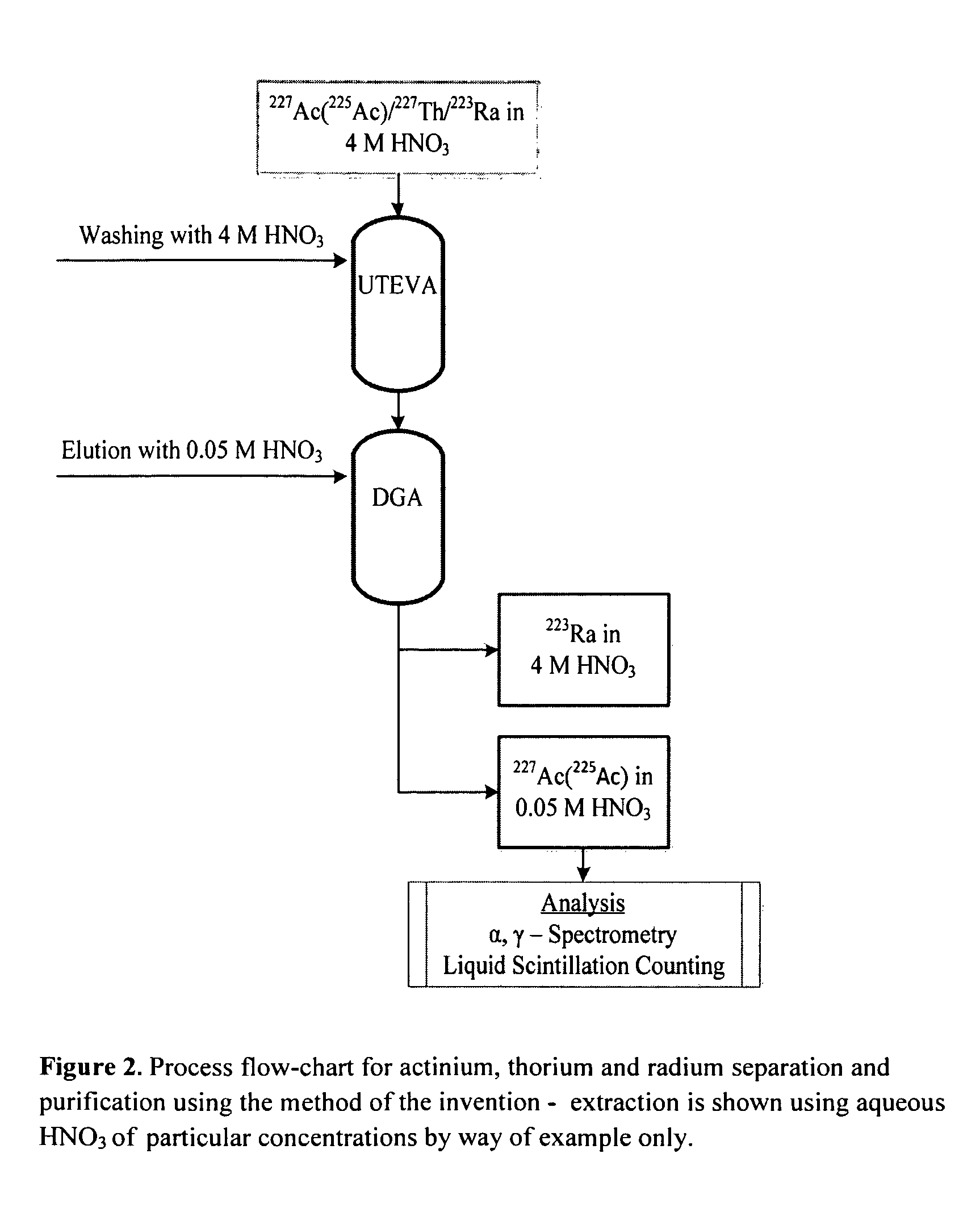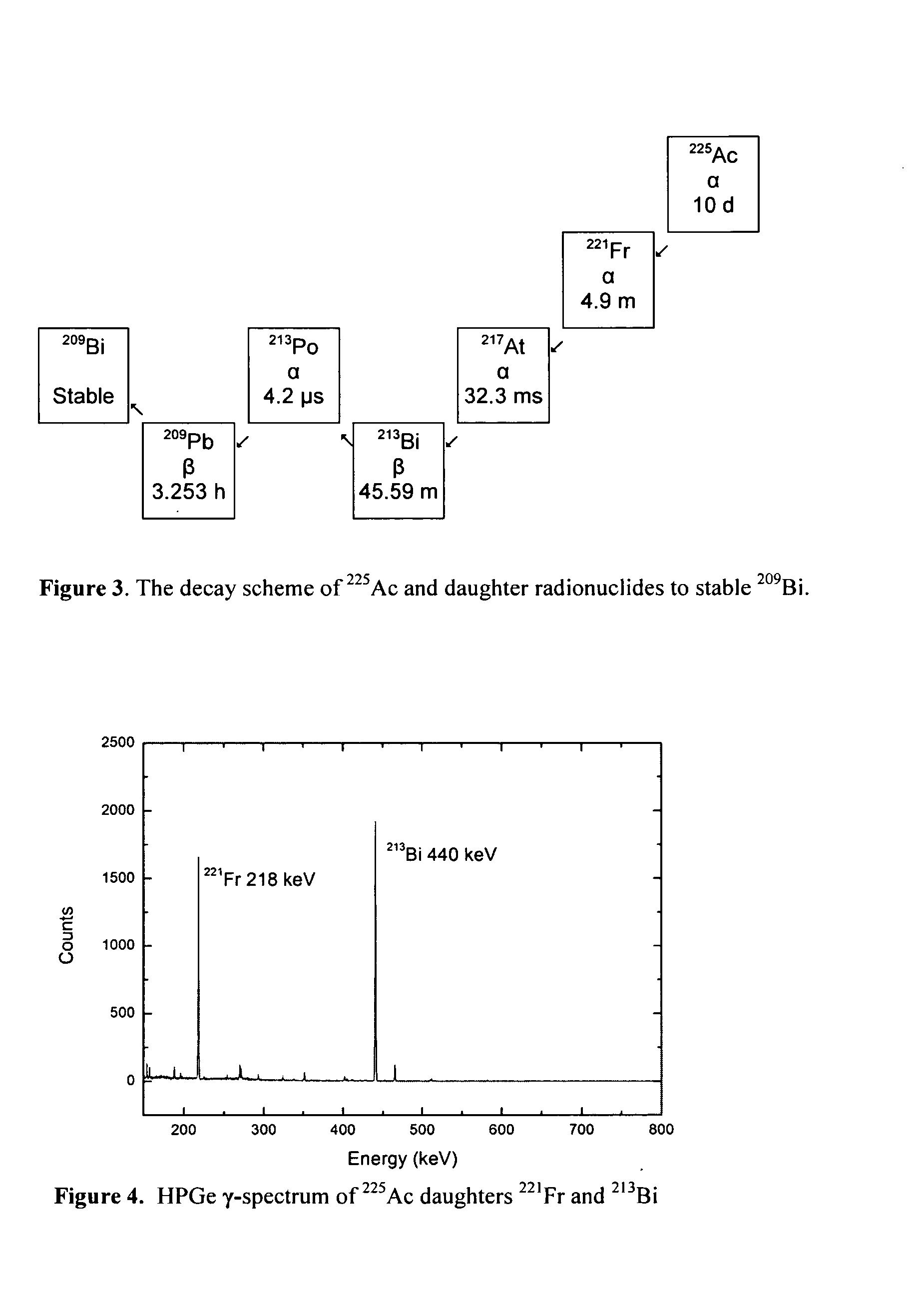Method for the quantification of 227ac in 223ra compositions
a 223ra composition and 227ac technology, applied in the field of 227ac quantification in 223ra compositions, can solve the problems of lack of selectivity for tumor cells and tumor tissue, inability to apply most often curative levels of treatment, and health and quality of life decline, etc., to achieve rapid quantification
- Summary
- Abstract
- Description
- Claims
- Application Information
AI Technical Summary
Benefits of technology
Problems solved by technology
Method used
Image
Examples
example 1
Separation of 225Ac from 227Th and 223Ra using Solid-Phase Extraction Columns
[0111]Sample Preparation, 225Ac
[0112]The 225Ac used was supplied from the Institute for Transuranium Elements, Karlsruhe, Germany. The solution had a nominal total activity of 6 MBq 225Ac at the day of receipt and the activity was diluted in 4 mol / L HNO3 to an activity of 3.1 Bq / μL.
[0113]A known amount of 227Th and 225Ac was added to 15 MBq 223Ra-chloride drug substance. The activity corresponded to approximately the specification limits of 227Th and 227Ac in a 223Ra-chloride drug substance. The specification states that the activity of 227Th should be less than 0.5% of 223Ra activity and the activity of 227Ac should be less than 0.004% of 223Ra. Table 3 gives the activities of 225Ac and 227Th used in the experiments.
TABLE 3Activities (Bq) of 227Th and 225Ac in experiment I and II.NuclideExperiment IExperiment II227Th (kBq)66.9 ± 2.21)74.6 ± 2.41)225Ac (Bq)497.7 ± 23.91)667.8 ± 33.41)1)Uncertainty in the ac...
example 2
Testing of the Robustness of the Method
[0140]Robustness of the method was tested by using new batches (new lot number) of UTEVA and DGA resin. The robustness of an analytical procedure is a measure of its capacity to remain unaffected by small variations in method parameters and provides an indication of its reliability during normal usage.
[0141]A total of three experiments (I, II and III) were conducted with 15 MBq 223Ra-chloride drug substance spiked with known activity of 225Ac. The activity of 225Ac is shown in Table 6. In addition, approximately 75 kBq of 227Th was added. The separation was performed according to the procedure given in Example 1.
[0142]Percentage recovery of 225Ac obtained after eluting with 5 ml 0.05 mol / L HNO3 was 68, 81 and 77%. The recoveries obtained were lower than for the UTEVA and DGA batches used in Example 1. It was therefore decided to increase the eluting volume (in addition to the 5 ml already added) by adding 2 times a volume of 2.5 ml of 0.05 mol / ...
example 3
Testing of the Range of the Method
[0143]Analytical methods developed by a pharmaceutical company must be validated. The method should be validated in the range from reporting limit to at least 120% of the specification limit. In the previous experiments, the amount of 225Ac has been added related to the specification limit. As the specification limit is 0.004% relative to 223Ra, approximately 600 Bq of 225Ac has been added to 15 MBq 223Ra. The purpose of Example 3 was to add lower and higher activities of 225Ac. The reason was to cover the range of amounts of 227Ac which would be used during validation. Three experiments were conducted with various amounts of 225Ac.
[0144]Results
[0145]Percent recovery of 225Ac obtained after elution of 10 ml 0.05 mol / L HNO3 were 91, 74 and 92%. The results are presented in Table 7. This shows that the recovery is acceptable (>70%) from 46 to 172% of the specification limit.
TABLE 7Measured 225Ac activity (Bq). Three experiments with an 225Acactivity r...
PUM
 Login to View More
Login to View More Abstract
Description
Claims
Application Information
 Login to View More
Login to View More - R&D
- Intellectual Property
- Life Sciences
- Materials
- Tech Scout
- Unparalleled Data Quality
- Higher Quality Content
- 60% Fewer Hallucinations
Browse by: Latest US Patents, China's latest patents, Technical Efficacy Thesaurus, Application Domain, Technology Topic, Popular Technical Reports.
© 2025 PatSnap. All rights reserved.Legal|Privacy policy|Modern Slavery Act Transparency Statement|Sitemap|About US| Contact US: help@patsnap.com



